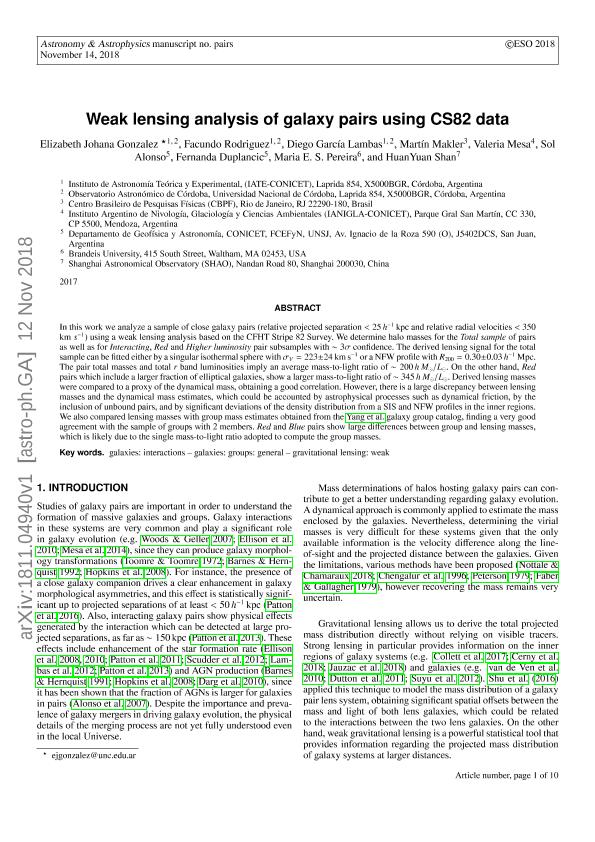Mostrar el registro sencillo del ítem
dc.contributor.author
Gonzalez, Elizabeth Johana

dc.contributor.author
Rodriguez, Facundo

dc.contributor.author
Garcia Lambas, Diego Rodolfo

dc.contributor.author
Makler, Martín

dc.contributor.author
Mesa, Valeria Alejandra

dc.contributor.author
Alonso, Sol

dc.contributor.author
Duplancic Videla, Maria Fernanda

dc.contributor.author
Pereira, Maria E. S.
dc.contributor.author
Shan, HuanYuan
dc.date.available
2021-01-26T16:43:07Z
dc.date.issued
2019-01
dc.identifier.citation
Gonzalez, Elizabeth Johana; Rodriguez, Facundo; Garcia Lambas, Diego Rodolfo; Makler, Martín; Mesa, Valeria Alejandra; et al.; Weak-lensing analysis of galaxy pairs using CS82 data; EDP Sciences; Astronomy and Astrophysics; 621; 1-2019; 1-10
dc.identifier.issn
0004-6361
dc.identifier.uri
http://hdl.handle.net/11336/123778
dc.description.abstract
Here we analyze a sample of close galaxy pairs (relative projected separation < 25 h -1 kpc and relative radial velocities < 350 km s -1 ) using a weak-lensing analysis based on the Canada-France-Hawaii Telescope Stripe 82 Survey (CS82). We determine halo masses for the total sample of pairs as well as for interacting, red, and higher-luminosity pair subsamples with ∼3σ confidence. The derived lensing signal for the total sample can be fitted either by a Singular Isothermal Sphere (SIS) with σ V = 223 ± 24 km s -1 or a Navarro-Frenk-White (NFW) profile with R 200 = 0.30 ± 0.03 h -1 Mpc. The pair total masses and total r band luminosities imply an average mass-to-light ratio of ∼200 h M ⊙ /L ⊙ . On the other hand, red pairs which include a larger fraction of elliptical galaxies, show a larger mass-to-light ratio of ∼345 h M ⊙ /L ⊙ . Derived lensing masses were compared to a proxy of the dynamical mass, obtaining a good correlation. However, there is a large discrepancy between lensing masses and the dynamical mass estimates, which could be accounted for by astrophysical processes such as dynamical friction, by the inclusion of unbound pairs, and by significant deviations of the density distribution from SIS and NFW profiles in the inner regions. We also compared lensing masses with group mass estimates, finding very good agreement with the sample of groups with two members. Red and blue pairs show large differences between group and lensing masses, which is likely due to the single mass-to-light ratio adopted to compute the group masses.
dc.format
application/pdf
dc.language.iso
eng
dc.publisher
EDP Sciences

dc.rights
info:eu-repo/semantics/openAccess
dc.rights.uri
https://creativecommons.org/licenses/by-nc-sa/2.5/ar/
dc.subject
GALAXIES: GROUPS: GENERAL
dc.subject
GALAXIES: INTERACTIONS
dc.subject
GRAVITATIONAL LENSING: WEAK
dc.subject.classification
Astronomía

dc.subject.classification
Ciencias Físicas

dc.subject.classification
CIENCIAS NATURALES Y EXACTAS

dc.title
Weak-lensing analysis of galaxy pairs using CS82 data
dc.type
info:eu-repo/semantics/article
dc.type
info:ar-repo/semantics/artículo
dc.type
info:eu-repo/semantics/publishedVersion
dc.date.updated
2020-11-18T21:19:59Z
dc.journal.volume
621
dc.journal.pagination
1-10
dc.journal.pais
Francia

dc.journal.ciudad
París
dc.description.fil
Fil: Gonzalez, Elizabeth Johana. Consejo Nacional de Investigaciones Científicas y Técnicas. Centro Científico Tecnológico Conicet - Córdoba. Instituto de Astronomía Teórica y Experimental. Universidad Nacional de Córdoba. Observatorio Astronómico de Córdoba. Instituto de Astronomía Teórica y Experimental; Argentina. Universidad Nacional de Córdoba. Observatorio Astronómico de Córdoba; Argentina
dc.description.fil
Fil: Rodriguez, Facundo. Consejo Nacional de Investigaciones Científicas y Técnicas. Centro Científico Tecnológico Conicet - Córdoba. Instituto de Astronomía Teórica y Experimental. Universidad Nacional de Córdoba. Observatorio Astronómico de Córdoba. Instituto de Astronomía Teórica y Experimental; Argentina. Universidad Nacional de Córdoba. Observatorio Astronómico de Córdoba; Argentina
dc.description.fil
Fil: Garcia Lambas, Diego Rodolfo. Consejo Nacional de Investigaciones Científicas y Técnicas. Centro Científico Tecnológico Conicet - Córdoba. Instituto de Astronomía Teórica y Experimental. Universidad Nacional de Córdoba. Observatorio Astronómico de Córdoba. Instituto de Astronomía Teórica y Experimental; Argentina. Universidad Nacional de Córdoba. Observatorio Astronómico de Córdoba; Argentina
dc.description.fil
Fil: Makler, Martín. Centro Brasileiro de Pesquisas Físicas; Brasil
dc.description.fil
Fil: Mesa, Valeria Alejandra. Consejo Nacional de Investigaciones Científicas y Técnicas. Centro Científico Tecnológico Conicet - Mendoza. Instituto Argentino de Nivología, Glaciología y Ciencias Ambientales. Provincia de Mendoza. Instituto Argentino de Nivología, Glaciología y Ciencias Ambientales. Universidad Nacional de Cuyo. Instituto Argentino de Nivología, Glaciología y Ciencias Ambientales; Argentina
dc.description.fil
Fil: Alonso, Sol. Universidad Nacional de San Juan. Facultad de Ciencias Exactas, Físicas y Naturales. Departamento de Geofísica y Astronomía; Argentina
dc.description.fil
Fil: Duplancic Videla, Maria Fernanda. Consejo Nacional de Investigaciones Científicas y Técnicas. Centro Científico Tecnológico Conicet - San Juan; Argentina. Universidad Nacional de San Juan. Facultad de Ciencias Exactas, Físicas y Naturales. Departamento de Geofísica y Astronomía; Argentina
dc.description.fil
Fil: Pereira, Maria E. S.. Brandeis University; Estados Unidos
dc.description.fil
Fil: Shan, HuanYuan. Shanghai Astronomical Observatory; República de China
dc.journal.title
Astronomy and Astrophysics

dc.relation.alternativeid
info:eu-repo/semantics/altIdentifier/url/https://arxiv.org/abs/1811.04940
dc.relation.alternativeid
info:eu-repo/semantics/altIdentifier/url/https://www.aanda.org/articles/aa/full_html/2019/01/aa34206-18/aa34206-18.html
dc.relation.alternativeid
info:eu-repo/semantics/altIdentifier/doi/https://doi.org/10.1051/0004-6361/201834206
Archivos asociados
